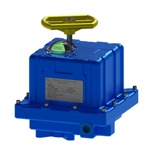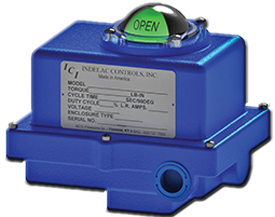A valve actuator is a mechanism designed to open or close a valve. With many different types and styles of actuator on the market, it can be difficult to decide on which actuator would be most appropriate for a specific use case, and it can be even more challenging to determine the type of controls for this actuator. This post will explore the different types of actuator controls and how to select the proper option for your application.

Local Valve Actuator Control Types
There are many different types of valve actuator controls, with each meant for different uses and applications. The most common local actuator control types include:
Open/Close Push Buttons
These have a simple operation, as the actuator reaches its desired position simply by the operator pushing a button. Open/close buttons are normally used with two-position actuators.
Open/Close Select Switch
This actuator control function similarly to the push-button. In this case, the actuator reaches its desired position through a switch interface. This is also used with two-position actuators.
4-20mA Input Transmitter
This control system is typically used with modulating actuators. It allows for more precise positioning through the use of a dial that begins at 4 and goes up to 20 milliamps (mA). This actuator has the capability to position a valve at any point between 0-100% open.
Remote/Off/Local
This control features a select switch that has three positions—remote, off, and local. Local offers local control at the actuator unit itself, which is often used to complement an open/close switch or a 4-20mA dial. Off is used for performing maintenance on the unit, as it cuts all power to the actuator, allowing the user to safely remove the cover. Remote lets users control the actuator from another location such as a control room or through a PLC.
At Indelac Controls, we can accommodate other control voltages, including 0-10 VDC and 0-135 ohms. We can also supply emergency stop or disconnect switches in the actuator control box.
How to Select the Right Actuator
Some of the questions you should ask when sourcing your actuator include:
- What is the voltage available to power the actuator?
- What is the environment like and are there hazards present? Hazards may include extreme temperatures, flammable/explosive environmental components, toxic fumes, or hazardous materials.
- How far away from the actuator will the control be? The answer to this question determines the wire gauge that will be used.
There are various safety measures that should be taken into account for different types of actuator controls. These include:
- Hazardous environments may require remote controls so technicians don't have to come into contact with hazards such as noxious fumes or high temperatures.
- Using emergency stop or disconnect switches lets technicians quickly stop processes during emergency conditions. They can be used along with a fail-safe device to kill power to the system, which will allow the spring or battery to return the valve to the fail-safe position.
Specific types of controls work best in certain environments, including:
- Oil, gas, and chemical processing applications require effective controls that include options for users to quickly set them to their fail-safe position.
- Many environments may also need remote controls to safely control valves located in hard to reach positions or in remote areas that take a long time to reach.
- Controls should be in place that will allow a technician to stay safe while performing maintenance.
Ask Indelac Controls Which Actuator is Right for You
Indelac Controls has a variety of control options to choose from, which are compatible with fail-safe actuators. When necessary, we can customize controls to fit specific application needs. We can provide the controls for any type of actuator, even if we didn't originally supply them. All of our products are engineered and manufactured in the United States, where they are subject to our stringent quality assurance.
For help selecting the appropriate actuator for your operation, please request a quote.






